The Dell XPS 13 (9300) Review: Return of the King
by Brett Howse on July 16, 2020 10:00 AM ESTSystem Performance
When we reviewed the XPS 13 2-in-1 back in November, it was the first device we had tested which featured the new 10 nm Intel Ice Lake platform. At that time, Dell had also recently refreshed the XPS 13, but had outfitted it with the older 14 nm Comet Lake platform. For the all-new XPS 13, Dell has now brought parity to their lineup with Ice Lake here as well, with the improvements that platform brings, especially to the graphics side.
Dell offers three processor options. The least-expensive offering is the Core i3-1005G1, the mid-tier outfitted with the Core i5-1035G1, and the top-tier offering the Core i7-1065G7. Our review unit features the Core i7 model, as Dell wanted to put its best foot forward.
On the memory side, Dell’s spec sheet shows a 4 GB base, although thankfully that is nowhere to be found on their Dell.com site, at least for the USA. Thanks to the move to LPDDR4X with Ice Lake, Dell now offers up to 32 GB of memory on the XPS 13. Storage is all PCIe x4 NVMe, with 256 GB as the base, and a 2 TB maximum.
To see how the XPS 13 performs, we have run it through our newly updated laptop suite. Please not that if a graph does not contain a specific older device, that means that the test has not been run on it. Since the laptops are returned to the manufacturer after review, we cannot do any regression testing for the most part. If you’d like to compare the XPS 13 to any other laptop we have tested, please refer to our Online Bench.
PCMark
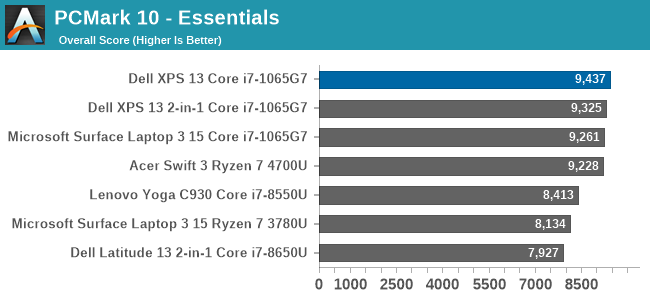
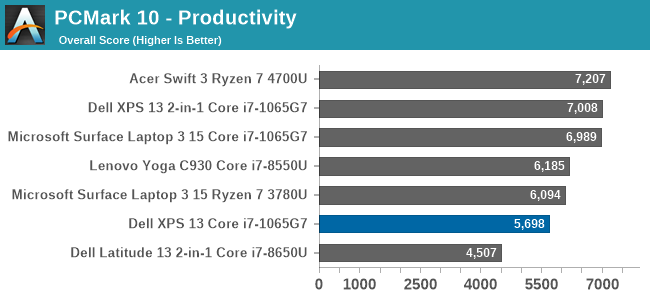
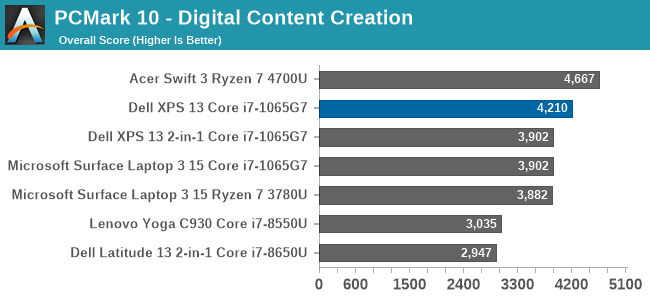
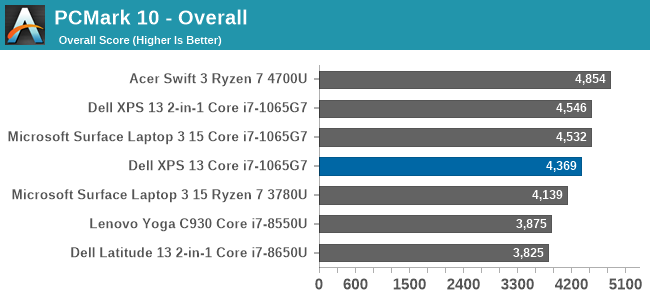
UL’s PCMark 10 is a whole-system benchmark, testing everything from CPU performance to app loading time. The Overall score consists of three categories, each featuring their own unique sub-tests. Overall the XPS 13 scored right in the same ballpark as other Ice Lake notebooks, although was slightly down in the Productivity tests, but slightly ahead in the other two.
Cinebench
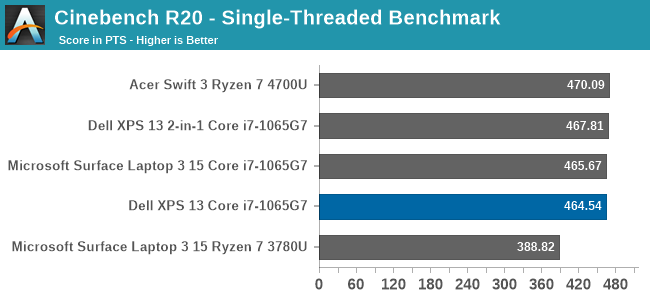
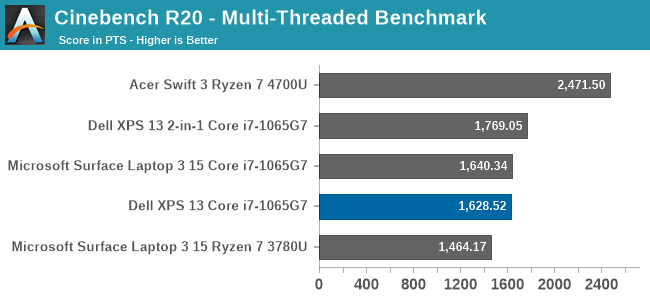
Cinebench, based on Maxon’s Cinema 4D rendering, allows tests of both single-threaded and multi-threaded runs, making it one of the more popular tests for overall computational performance. The XPS 13 does well compared to other Ice Lake equipped notebooks, although with AMD offering up to 8 cores in the same 15-Watt TDP, Intel falls behind in the multi-threaded run.
Handbrake
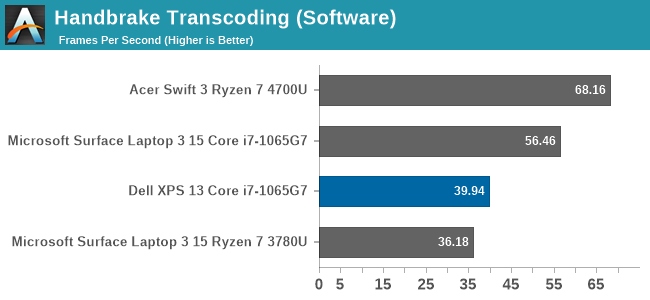
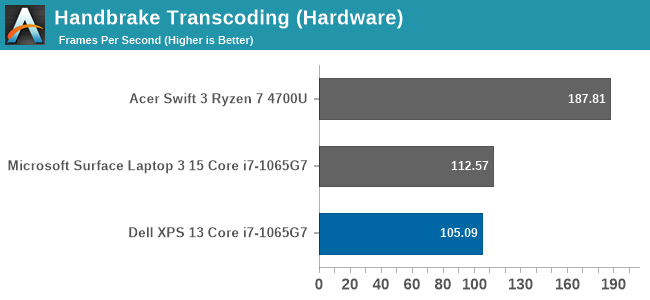
In our Handbrake encoding test, we transcode a 1080p movie to 720p using both software and hardware encoders. Software encoders utilize the CPU, and are generally the preferred method for optimal quality, whereas hardware encoders leverage the media blocks, which in this case is Intel’s QuickSync, for a much faster encode. As we will see more in the thermals section, Dell limits the XPS 13 to a 15-Watt TDP even in its maximum performance mode, where some other manufacturers will allow for higher than listed TDP, up to 20 Watts or so, and as such, the XPS 13 falls a bit behind other Ice Lake notebooks in this test which is TDP limited.
7-Zip


The popular file compression and decompression tool 7-Zip includes a built-in benchmark, and once again the XPS 13 slots right into where other Ice Lake notebooks fit.
Web Tests
Web performance is a function of not only the CPU performance, but also the browser’s scripting engine, and as such we have standardized on the Microsoft Edge browser. Microsoft has now transitioned their browser to the open-source Chromium project. Due to this, we have reset our web tests to use the new Chromium based Edge and taken the opportunity to decommission some of the older tests. We will now focus on Speedometer 2.0 and WebXPRT 3.
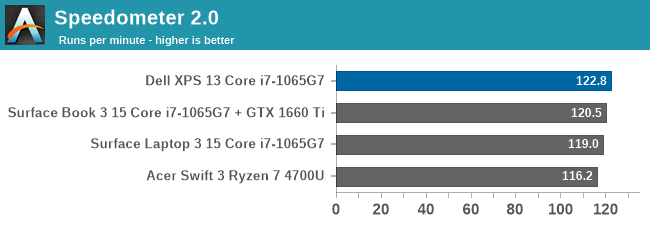
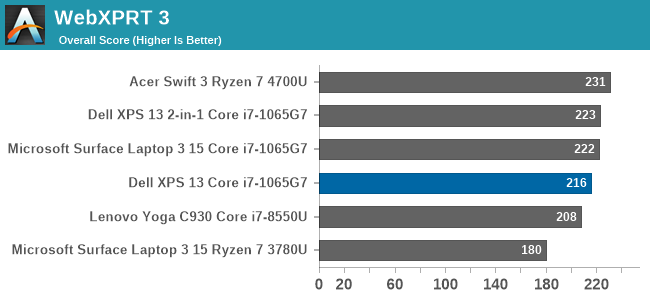
The XPS 13 again slots right in where you would expect for an i7-1065G7 based system.
Storage Performance
Dell offers from 256 GB to 2 TB of PCIe storage, and the review unit was outfitted with the Intel 600p 512 GB drive. We are transitioning to the PCMark 10 storage benchmark, which uses test traces of actual common workloads, such as booting Windows, and many of the Adobe applications, and as such should be a much better indicator of drive performance than just maximum transfer rates.
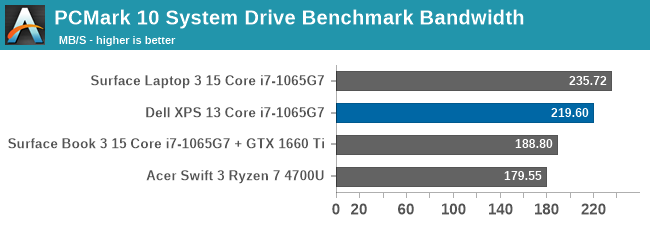
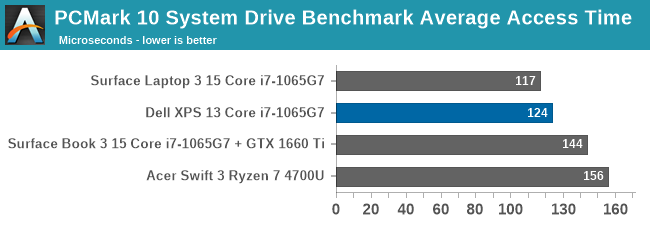

The Intel 600p performs quite well, with good access times and solid bandwidth. Surprisingly, it can’t quite match the excellent performance we saw from the SK Hynix 2230 form factor SSD in the Surface Laptop 3, but almost matches it.











224 Comments
View All Comments
Deicidium369 - Friday, July 17, 2020 - link
I agree. OEMs will build what their customers want. I just don't see people clamoring for an AMD over an IntelKorguz - Friday, July 17, 2020 - link
of course you dont, cause you can only see intel, no matter what.vladx - Saturday, July 18, 2020 - link
No we can certainly see AMD with how they fail time and time again to launch reliable products and platforms.Korguz - Saturday, July 18, 2020 - link
seems your god intel seems to be failing quite a lot the last few years.vladx - Saturday, July 18, 2020 - link
Sorry that you're so butthurt that you try to mock others, Intel sells best because they are very reliable unlike AMD.Korguz - Saturday, July 18, 2020 - link
sorry you are butthurt cause your god intel has screwed up so bad the last few years, and that you blind to see anything else.rhysiam - Thursday, July 16, 2020 - link
Oh come on, this cherry picked "17%" claim again? See my post above. The very review you are commenting on shows highly threaded workloads pushing to AMD's advantage in the 34% to 79% range, depending on the specific workload. That is **not** "virtually matching"... and the 4700U is **not** the top Renoir.Deicidium369 - Friday, July 17, 2020 - link
"Summing up the performance metrics, the Intel Core i7-1165G7 has a lead of up to 20% in single-core performance tests while featuring a 10% clock speed advantage over the Ryzen 7 4800U (4.2 GHz vs 4.7 GHz). In multi-core tests, the Ryzen 7 4800U is 17% faster but that is despite the AMD chip having twice the number of cores and threads. But that's the fastest score for the chip with Linux OS which tends to offer higher scores. Compared to a Ryzen 7 4800U on Windows OS, the Core i7-1165G7 leads by up to 35% in single-core while being just 6% slower than its 8 core & 16 thread competitor."https://wccftech.com/intel-10nm-core-i7-1165g7-cpu...
34% higher performance in single core - slightly higher clock, but not 34% higher clocks - that's a nice IPC gain.
Not seeing the 34 to 79% AMD advantage in multicore. I am seeing the multicore being between 17% slower and 6% slower depending on the OS - with 8 cores & 16 threads vs 4 cores and 8 threads.
Just so we are working from the same materials.
Korguz - Friday, July 17, 2020 - link
yea, wccftech is a trust worthy source, arent they mostly a rumor/BS site ?Spunjji - Monday, July 20, 2020 - link
WCCFTech were running with rumours that Zen 2 would hit ~5Ghz for months before it was released, so yeah, I'd say their record isn't particularly reliable.Their comments section is also notoriously full of trolls and jackasses...